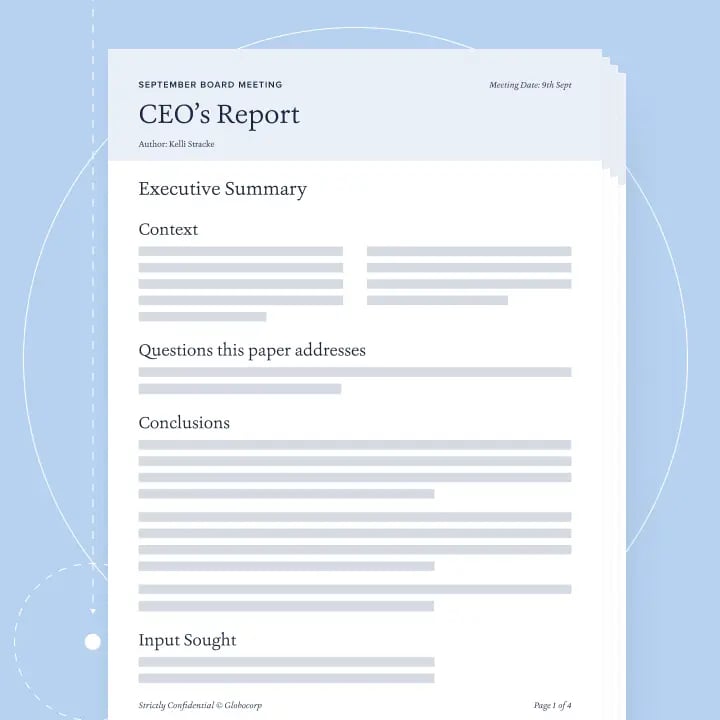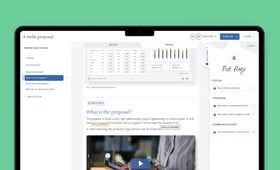According to the latest data, it’s difficult to overstate how much the world of work has been transformed in the past few years, but also how little board packs have improved over the same period.
In 2018, we launched a joint effort with the Chartered Governance Institute UK & Ireland to help organizations score their board packs. As the board pack contains a company’s most confidential information, objectively benchmarking it against peers is inherently difficult, so the goal was to draw back the curtain and help boards, governance professionals, and management teams understand how they fared.
The initiative included two self-survey tools:
- A board pack assessment tool to identify the strengths and weaknesses of both the board pack (across its style, scope, and content) and board reporting cycle.
- A board reporting calculator to work out the hidden costs of the full board reporting process, based on the number of directors and meetings, the length of the pack, and the distribution method.
What do the results tell us about the state of board reporting?
Since their launch, over 1,000 directors, C-suite executives, and governance professionals from nearly 700 organizations across sectors have filled out these survey tools. And the results are damning: over the past five years, not only have board packs been getting longer, but the quality of insight they bring to bear has also been declining.
Not even half of directors get value from their board papers
Let’s start with the good news: 2022, when more boards and governance professionals found their papers to be hindering the board conversation (30%) than helping (28%), seems to have been the low point, while 2023 shows a marked improvement.
The bad news? Less than half of board papers (48%) add value in the eyes of their readers, with the rest considered as either having no impact (42%) or being an obstacle (10%).
In total, 63% of board members and governance professionals score their board packs as “weak” or “poor” (marking a slight improvement from the 2018–2022 average of 70%).
Our board papers…
And just over half of directors think their management team spends enough time on reporting
To make matters worse, the leaders who believe that their management team spends enough time writing their board papers are just a slim majority (57%), despite the length of board packs increasing overall.
- The average board pack is now 226 pages long (up 30% since 2019, and consistent with our earlier research with Cambridge Judge Business School, which found the median length at around 200 pages). Only 40% of board packs remain below the 100-page mark.
- One-quarter of board members and governance professionals (24%) think the time taken by management for board reporting is insufficient, and another 19% are unsure.
The time taken by management for board reporting is…
What do low-quality board packs reveal about the organizations producing them?
The board pack acts as a “canary in the coal mine.” A poor-quality board pack is almost always symptomatic of:
- A lack of critical thinking among management more broadly,
- A lack of clear focus and alignment around what matters most, and
- Insufficient communication between management and the layers below.
This makes boards slow to spot risks and opportunities within the business, slow to make decisions, and slow to execute strategic and directional changes. And in times of such rapid transformation, that’s a risky place to be.
Having sat in on hundreds of board meetings over the years, we’ve witnessed firsthand how board pack quality can determine the quality of the board discussion and the board meeting itself. Done well, it can set the board up for success, allowing for strategic, forward-looking conversations about the things (and the various stakeholders) that really matter.
Where do board packs go wrong?
So, what’s going awry in the board reporting process? It’s not that report authors are lazy and don’t write enough. Rather, they’re underequipped for the job and so write the wrong way about the wrong things.
Case in point, looking at data covering 2020 through 2023:
- 54% of board members and governance professionals feel that finding the key messages in their board papers is like looking for a needle in the haystack.
- 62% think that the management information they’re given is too operational and not strategic enough.
- 54% find that their board reports are too introspective.
- 38% say they don’t accurately reflect their organizations’ priorities.
The key messages in our board packs…
How do you fix poorly written board packs?
But just because the stats paint a negative picture, it doesn’t mean this downward trend has to continue. The best board packs follow the tenets of the Question-Driven Insight (QDI) principle, a method ensuring that each paper within it is built on robust and critical thinking, is communicated effectively, and focuses on what matters.
Lucia, our AI-powered thinking and writing platform, embeds this QDI principle, equipping authors with the tools and real-time feedback they need to compose papers that get to the heart of what matters. Lucia acts as a skilled editor and critical supporter, helping even novice writers strike the balance between information and insight, past performance and future outlook, what’s gone well and what hasn’t. This makes it easier to create a high-quality executive summary that showcases the key points upfront.
So:
- If you want to know how your board pack stacks up, fill in the board pack assessment tool for yourself.
- If you know that improvements are needed but aren’t sure where to start, read our guide to best-practice executive summaries and watch our “How to write a great…” video series.
- If you’re ready to transform your reporting at scale, book your demo of Lucia, our management reporting platform that helps you write brilliant reports to spur your business to action.




